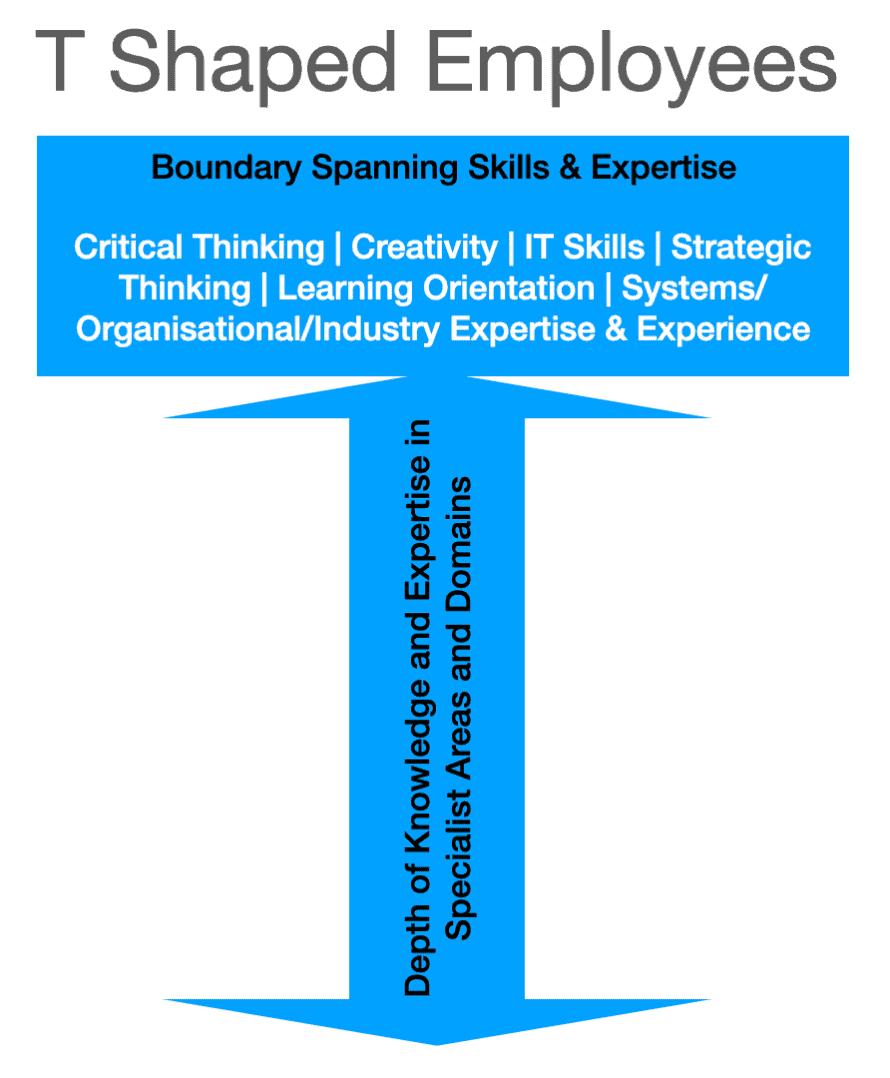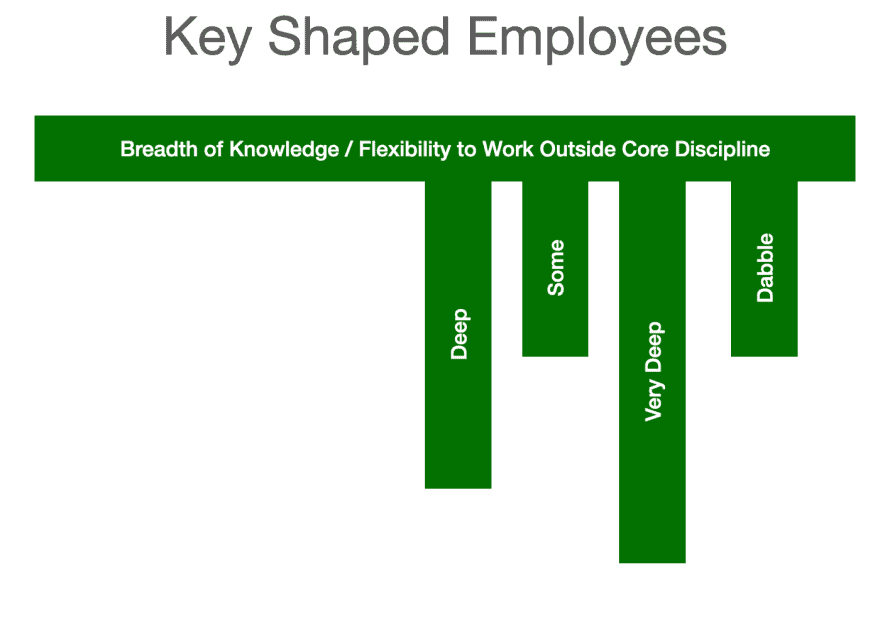- in Blog by David Wilkinson
- |
- 1 comments
New research: The shift between T-Shaped & Key-shaped employees

Traditional ways of thinking about employee and manager skills are being upended by the pace of change. The T-shaped employee is being replaced by Key-Shaped employees and managers…
In 1978 an almost unreported paper published in the Institute of Electrical and Electronics Engineers Journal, The Engineering Management Review by Denis Johnson a little-known electronics engineer, showed that managers of the day were having to be both specialists and generalists in what he termed as the ‘T’ shaped manager.
The idea of T-shaped manager
The idea behind the ‘T’ shaped manager was that they need in-depth knowledge of the industry or craft, whilst at the same time having broad and wide-ranging knowledge, understanding and experience of a range of other topics, such as management, human resources, business etc.

As can be seen from figure 1 above, the classic ‘T’ shape describes the mix of knowledge, skills and competencies that most managers in organisations require. The horizontal bar describes the boundary-crossing competencies and the vertical bar describes the individual’s depth of knowledge within their particular skill or specialist area.
So, for example, an engineer may be promoted to become a manager and needs to understand both the engineering discipline within which they have developed over the years and also now a set of more generic skills and knowledge to enable them to operate as an effective manager within an organisation.
Since 1978 the concept has caught on and matured over the years, with significant amounts of research looking at it particularly, but not exclusively, in the United States and primarily in more technical industries, such as engineering, electronics and, more recently, IT industries.
T-shaped employee
A recent review of the research found that the classic ‘T’ shaped manager had morphed into the ‘T’ shaped employee, particularly in the aftermath of the 2008 global financial crash. Since 2008, the study found that organisations have generally increased their interest in employees, not just managers, becoming more entrepreneurial in their thinking, and are striving to develop more entrepreneurial cultures across their organisations.

Alongside this review, a small but growing series of other papers have started to question whether the classic ‘T’ shape needs redefining. In particular, studies in 2015, 2018 and 2019 are showing that the current and projected requirements for managers and employees is starting to shift towards a ‘key’ shape.
More than one deep skill & knowledge set
This means that individuals, particularly managers, need to have the horizontal broad boundary-crossing knowledge and skills described by the classic ‘T’ shape, but organisations are now requiring more than just one set of deeper areas of skills and knowledge.
In particular, the studies show that managers and many employees must work outside of their discipline or area of expertise. This means that just having one area of expertise and in-depth knowledge is no longer enough, particularly in situations where there is high levels of change (usually technology or market-based change). Besides their own area of discipline or expertise, modern managers must have other areas of specialisms as well.

Emergence of key-shaped people
The mixture of these deeper vertical areas frequently depends on the organisation and its context; however, it is being found that individuals with transdisciplinary knowledge and skills have a significant advantage for problem-solving, innovation and general creativity. Indeed, one pattern appearing in the research is that transdisciplinary project teams are increasingly becoming the norm within organisations and research institutions. Current research is showing that transdisciplinary teams have a significant advantage when tackling ‘wicked problems’. Further, managing and being a member of a transdisciplinary team also requires transdisciplinary managers and team members for effective performance.

Several studies show that the combination of ‘teeth’ on the key shape across the team can leverage significant advantages.
Transdisciplinary team management
It is becoming recognised that transdisciplinary team formation and management is itself a wicked problem, requiring considerably distinct sets of skills and knowledge (key-shaped) than the classic management profile.
Three fundamental characteristics of wicked problems
The issue with wicked problems is that they are dynamic and have:
- No definitive definition.
- No stopping rule or clear understanding of when the problem is finally solved.
- Every solution is a one-shot or one chance operation, each of which has consequences from which there is no going back. Therefore, there is no opportunity for trial and error testing.
One of the ‘teeth’ of the key where managers need deeper levels of knowledge and understanding (and experience), is of problem-solving using teams and often the depth of knowledge, understanding, analysis and skills to deal with uncertainty and wicked problems

Conclusion
Whilst this level of research is in its infancy and is emergent, the trend is certainly towards multi-skilled and multi-knowledge, or key-shaped, professionals.
Clearly, this emerging paradigm has significant implications for operational management, organisational structures, management development, organisational development and design, human resources and human resource management.
References
Johnston, D. L. (1978). Scientists become managers-the’T’-shaped man. IEEE Engineering Management Review, 6(3), 67-68. Demirkan, H. & Spohrer, J. (2015). T-shaped innovators: Identifying the right talent to support service innovation. Research-Technology Management, 12-15.
Neeley, K. A., & Steffensen, B. (2018). The T-Shaped Engineer as an Ideal in Technology Entrepreneurship: Its Ori-gins, History, and Significance for Engineering Education. In Proceedings of the American Society for Engineering Education.
Bridgestock, R. (2015). KEY-shaped people, not T-shaped people – disciplinary agility and 21st century work. Retrieved from http://www.futurecapable.com/?p=102
Korte, W. B., Hüsing, T., & Dashja, E. (2018). T-shaped Professionals in Europe Today and in 2020. T-Shaped Professionals: Adaptive Innovators.
Hart, J. L. (2019). Interdisciplinary project-based learning as a means of developing employability skills in undergraduate science degree programs. Journal of Teaching and Learning for Graduate Employability, 10(2), 50-66.
Norris, P. E., O’Rourke, M., Mayer, A. S., & Halvorsen, K. E. (2016). Managing the wicked problem of transdisciplinary team formation in socio-ecological systems. Landscape and Urban Planning, 154, 115-122.
Be impressively well informed

Get the very latest research intelligence briefings, video research briefings, infographics and more sent direct to you as they are published
Be the most impressively well-informed and up-to-date person around...

I understand the need but how does a professional find the time to keep up to date with all the different expertise? I’m a devops engineer with experience in development and operations where I now also have to do to Infra as Code. As a result, it’s been 3 years since I really programmed. Do managers really expect me to now know what’s going on in the world of dev and easily switch to programming more if asked? I don’t mind, but they can’t expect the same level of speed and delivery.